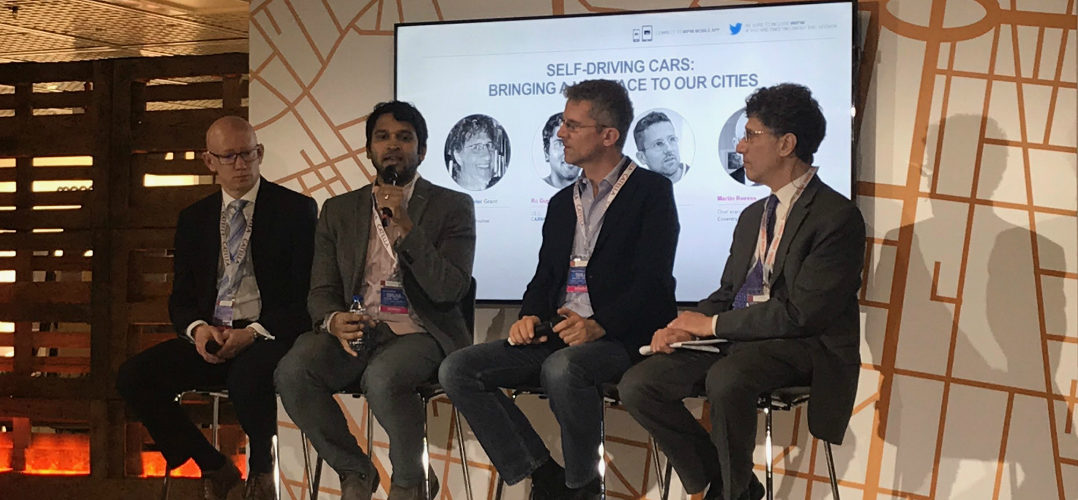The traditional concept of car and driver is central to the design and development of the modern city but how will self-driving cars disrupt this conventional model and how will the future city need to adapt? In the session, “Self-driving cars: bringing a new face to our cities,” each panelist provided their own insight as well as some predictions for the future on how autonomous vehicles will change our future cities and how we can better prepare.
Panellists included: Martin Reeves, CEO, Coventry City Council, Ro Gupta, CEO, CARMERA, Carlo Ratti, Director, Carlo Ratti Associti, Moderator: Peter Grant, Wall Street Journal
Moderator Peter Grant from the Wall Street Journal, called upon the expertise of each panelists, asking several questions about autonomous vehicles and their effects.
Carlo Ratti, Director of Ratti Associti and architect and affiliate with MIT, is optimistic that streets will be safer and that self-driving cars and artificial intelligence will be able to drive cars in a much safer way. He believes the most exciting thing to come from self-driving cars is what the consequences to a city will be. One of the consequences is that the use of cars will become more efficient and therefore parking infrastructure will become more efficient. Today, cars are only used 5% of the time. Instead of using your car to drive to work in the morning and then parking it for the day, it can be used to transport other members of your family or can be used for other reasons throughout the day. This will free up parking space and parking infrastructure can be adjusted over time to take this into account.
Martin Reeves, CEO of Coventry City Council, is working to future proof, the city of Coventry, partnering with tech partners across the UK and testing autonomous technology and looking at how it will change the city scape. They are taking measures to update city infrastructure as technology continues to change. Reeves challenged the audience to think about how big of an impact technology will have and the effects it will have on a city.
Ro Gupta’s company, CARMERA, is building high definition maps for driverless cars to navigate safely. They use a variety of methods to collect data and have recognized it is not sufficient to be just a narrow technology solution. They’ve found creative ways to partner with local communities and governments to help collect their data. Gupta believes that you need to think about things holistically because there are a lot of stakeholders involved in these deployments.
The panel continued with some questions from moderator Peter Grant.
Peter Grant: How do driverless cars fit into the city?
Carl Ratti described some of the questions that will arise concerning self-driving cars including whether or not there will be more or less sprawl or even more or less cars. The short answer is we do not know. Cost per mile can decrease significantly with self-driving cars. If you have no taxation in place, you may see more sprawl because you can commute much longer distances. Which way we go or which scenario we will see will depend on the decisions we make, especially surrounding policies.
Peter Grant: How might cities of the future look different?
Martin Reeves believes we will see a lot of narrow streets and more space given to pedestrians. A city will need to think about what the scenarios may be with self-driving cars including the volumes. Different scenarios should be evaluated with the help of sensors and data to help predict these scenarios in much more coherent ways.
Peter Grant: Any design implications, and working in a closed loop environment?
Ro Gupta described a retirement community in Florida where CARMERA has installed data collectors. Self-driving technology has been deployed in this type of closed loop environment first and more often because of the benefits is provides including creating geo fence, selective environmental climates, and organized management. CARMERA and the retirement community ultimately both benefit from having this technology installed in the community.
Peter Grant: Buildings are designed to last 30-40 years, and with all of the changes we see coming in the near future, how do you develop property today, and what are the challenges especially with parking?
It is true that things are changing at a rapid pace. As an example, there has been a significant increase of coworking space and the need for less space. These changes affect how we think about real estate. Carl Ratti stressed that digital is entering physical space, and therefore we are seeing huge changes in space requirements, tenants are requiring less space. Traffic and driving is experiencing this same trend with the development of new technologies driving changes in the automobile industry.
Peter Grant: Can we design buildings today to anticipate and accommodate the parking needs of today and alter it for the future?
We still have to obey by building standards today, Carl Ratti explains, but there are ways to anticipate changes including installing parking ramps on the outside and also building higher floor to ceiling heights. Parking structures can be designed now assuming a potential alternate use.
Peter Grant: How can infrastructure today be changed?
Ro Gupta has two recommendations for builders. First, think about future proofing, or building infrastructure today that takes into account and anticipates changes and advances. Will you need to convert a parking structure into an apartment complex? Second, think about the curb. Curbs will be more pronounced in the future. If people are more incentivized to take self-driving cars and not park their cars in parking garages, most of these transactions will take place at the curb. In most cities now, curbs are not prepared to accommodate for these transactions and therefore should be considered.
Peter Grant: What do you predict are the stages of the adoption of driverless vehicles and when will we get there?
According to Ro Gupta, the real answer is no one knows. This is still a decades of long evolution with so much complexity and it varies considerably in different parts of the world. The future is here – just not evenly distributed. Carl Ratti believes it is going to take a few years, but going to happen faster than we expect. Martin Reeves thinks it will follow an adoption curve over the next 2-3 years.
Whitney Jorgensen is a licensed real estate salesperson in the state of California and has experience managing class A commercial office buildings. She received her Bachelor of Science in Regional Development from the University of Arizona and is a Master of Science in Real Estate candidate at University of San Diego. She is currently interning as an Investment Analyst at Kilroy Realty Corporation.



